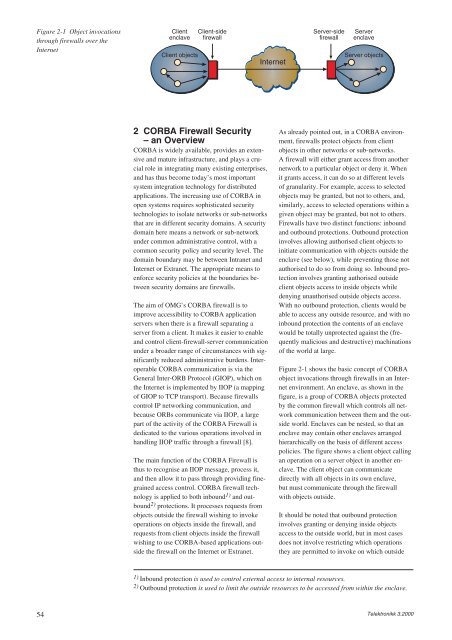Security - Telenor
Security - Telenor
Security - Telenor
Create successful ePaper yourself
Turn your PDF publications into a flip-book with our unique Google optimized e-Paper software.
Figure 2-1 Object invocations<br />
through firewalls over the<br />
Internet<br />
54<br />
Client<br />
enclave Client-side<br />
firewall<br />
Client objects<br />
2 CORBA Firewall <strong>Security</strong><br />
– an Overview<br />
CORBA is widely available, provides an extensive<br />
and mature infrastructure, and plays a crucial<br />
role in integrating many existing enterprises,<br />
and has thus become today’s most important<br />
system integration technology for distributed<br />
applications. The increasing use of CORBA in<br />
open systems requires sophisticated security<br />
technologies to isolate networks or sub-networks<br />
that are in different security domains. A security<br />
domain here means a network or sub-network<br />
under common administrative control, with a<br />
common security policy and security level. The<br />
domain boundary may be between Intranet and<br />
Internet or Extranet. The appropriate means to<br />
enforce security policies at the boundaries between<br />
security domains are firewalls.<br />
The aim of OMG’s CORBA firewall is to<br />
improve accessibility to CORBA application<br />
servers when there is a firewall separating a<br />
server from a client. It makes it easier to enable<br />
and control client-firewall-server communication<br />
under a broader range of circumstances with significantly<br />
reduced administrative burdens. Interoperable<br />
CORBA communication is via the<br />
General Inter-ORB Protocol (GIOP), which on<br />
the Internet is implemented by IIOP (a mapping<br />
of GIOP to TCP transport). Because firewalls<br />
control IP networking communication, and<br />
because ORBs communicate via IIOP, a large<br />
part of the activity of the CORBA Firewall is<br />
dedicated to the various operations involved in<br />
handling IIOP traffic through a firewall [8].<br />
The main function of the CORBA Firewall is<br />
thus to recognise an IIOP message, process it,<br />
and then allow it to pass through providing finegrained<br />
access control. CORBA firewall technology<br />
is applied to both inbound 1) and outbound<br />
2) protections. It processes requests from<br />
objects outside the firewall wishing to invoke<br />
operations on objects inside the firewall, and<br />
requests from client objects inside the firewall<br />
wishing to use CORBA-based applications outside<br />
the firewall on the Internet or Extranet.<br />
Internet<br />
Server-side<br />
firewall<br />
Server<br />
enclave<br />
Server objects<br />
As already pointed out, in a CORBA environment,<br />
firewalls protect objects from client<br />
objects in other networks or sub-networks.<br />
A firewall will either grant access from another<br />
network to a particular object or deny it. When<br />
it grants access, it can do so at different levels<br />
of granularity. For example, access to selected<br />
objects may be granted, but not to others, and,<br />
similarly, access to selected operations within a<br />
given object may be granted, but not to others.<br />
Firewalls have two distinct functions: inbound<br />
and outbound protections. Outbound protection<br />
involves allowing authorised client objects to<br />
initiate communication with objects outside the<br />
enclave (see below), while preventing those not<br />
authorised to do so from doing so. Inbound protection<br />
involves granting authorised outside<br />
client objects access to inside objects while<br />
denying unauthorised outside objects access.<br />
With no outbound protection, clients would be<br />
able to access any outside resource, and with no<br />
inbound protection the contents of an enclave<br />
would be totally unprotected against the (frequently<br />
malicious and destructive) machinations<br />
of the world at large.<br />
Figure 2-1 shows the basic concept of CORBA<br />
object invocations through firewalls in an Internet<br />
environment. An enclave, as shown in the<br />
figure, is a group of CORBA objects protected<br />
by the common firewall which controls all network<br />
communication between them and the outside<br />
world. Enclaves can be nested, so that an<br />
enclave may contain other enclaves arranged<br />
hierarchically on the basis of different access<br />
policies. The figure shows a client object calling<br />
an operation on a server object in another enclave.<br />
The client object can communicate<br />
directly with all objects in its own enclave,<br />
but must communicate through the firewall<br />
with objects outside.<br />
It should be noted that outbound protection<br />
involves granting or denying inside objects<br />
access to the outside world, but in most cases<br />
does not involve restricting which operations<br />
they are permitted to invoke on which outside<br />
1) Inbound protection is used to control external access to internal resources.<br />
2) Outbound protection is used to limit the outside resources to be accessed from within the enclave.<br />
Telektronikk 3.2000

















